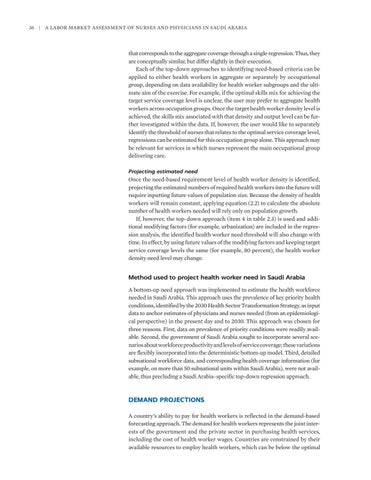36 | A Labor Market Assessment of Nurses and Physicians in Saudi Arabia
that corresponds to the aggregate coverage through a single regression. Thus, they are conceptually similar, but differ slightly in their execution. Each of the top-down approaches to identifying need-based criteria can be applied to either health workers in aggregate or separately by occupational group, depending on data availability for health worker subgroups and the ultimate aim of the exercise. For example, if the optimal skills mix for achieving the target service coverage level is unclear, the user may prefer to aggregate health workers across occupation groups. Once the target health worker density level is achieved, the skills mix associated with that density and output level can be further investigated within the data. If, however, the user would like to separately identify the threshold of nurses that relates to the optimal service coverage level, regressions can be estimated for this occupation group alone. This approach may be relevant for services in which nurses represent the main occupational group delivering care. Projecting estimated need
Once the need-based requirement level of health worker density is identified, projecting the estimated numbers of required health workers into the future will require inputting future values of population size. Because the density of health workers will remain constant, applying equation (2.2) to calculate the absolute number of health workers needed will rely only on population growth. If, however, the top-down approach (item 4 in table 2.3) is used and additional modifying factors (for example, urbanization) are included in the regression analysis, the identified health worker need threshold will also change with time. In effect, by using future values of the modifying factors and keeping target service coverage levels the same (for example, 80 percent), the health worker density need level may change.
Method used to project health worker need in Saudi Arabia A bottom-up need approach was implemented to estimate the health workforce needed in Saudi Arabia. This approach uses the prevalence of key priority health conditions, identified by the 2030 Health Sector Transformation Strategy, as input data to anchor estimates of physicians and nurses needed (from an epidemiological perspective) in the present day and to 2030. This approach was chosen for three reasons. First, data on prevalence of priority conditions were readily available. Second, the government of Saudi Arabia sought to incorporate several scenarios about workforce productivity and levels of service coverage; these variations are flexibly incorporated into the deterministic bottom-up model. Third, detailed subnational workforce data, and corresponding health coverage information (for example, on more than 50 subnational units within Saudi Arabia), were not available, thus precluding a Saudi Arabia–specific top-down regression approach.
DEMAND PROJECTIONS A country’s ability to pay for health workers is reflected in the demand-based forecasting approach. The demand for health workers represents the joint interests of the government and the private sector in purchasing health services, including the cost of health worker wages. Countries are constrained by their available resources to employ health workers, which can be below the optimal

